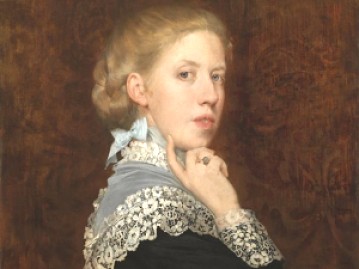
Elza Ransonnet Villez (self portrait) 1878
(Florence, Uffizi Gallery)
| ANNE WANNER'S Textiles in History / symposiums |
| HEIRLOOMS,
CATASTROPHES AND SURVIVAL ROSALIA BONITO FANELLI (Florence, Italy March 2016) The Davanzati Palace
also known as The Museum of the Florentine
Renaissance Home was struck by a disastrous
storm in September 2014. The catastrophe destroyed
especially the museum area holding the lace and textiles
and pertinent paintings. And now,
finally, the rooms have been reopened and the lace and
samplers again are on view after attentive cleaning and
restoration by Beyer & Perrone da Zara and Tela
di Penelope. The lace
display originatedl there in 1981 due to the
then-director Maria Fossi Todorow who grew up in the
Anglo-american colony of Florence. Edith
Bronson Rucellai was her grandmother who had
collected bits of lace in scrap books. In fact,
many members of the original Needle and Bobbin Club of
New York associated with the Metropolitan Museum were
also part of this world. |
|
|
|
| On the Grand tour young ladies came
to Florence to have their embroidered trousseaux made:
personal items such as dozens of monogrammed
handkerchiefs, lacy peignoirs, nightgowns and
underwear. But also tablecloths and napkins, table
runners and curtains; christening robes and caps. These
then were handed down for generations. These
fragile gossamer silks and cambric linens became
heirlooms. Now many
of these delicate mementos have finished as donations or
sales to museum collections. Much of the lace and
embroidered linens reached the Davanzati Palace Museum
directly from the family owners. These objects have
lived. And some even have poignant stories connected to
them. The ladies from a Henry James novel or an
heirless family committed these precious bits of lace and
embroidery to museum care. So thus a private life
becomes History. That’s what museums are for. ps In another short note I shall
discuss the origin of the sampler collection in the
Davanzati Palace Museum |
| home content | Last revised 19 March 2016 |